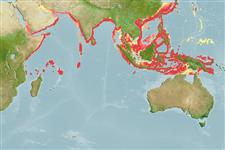Environment: milieu / climate zone / depth range / distribution range
Ekologi
laut; payau bentopelagis; oceanodromus (Ref. 51243); kisaran kedalaman 50 - ? m (Ref. 9987). Tropical; 31°N - 12°S, 40°E - 153°E (Ref. 54462)
Indo-West Pacific: Somalia to Papua New Guinea, north to Japan and south to Indonesia.
Length at first maturity / Size / Weight / umur
Maturity: Lm ?, range 13 - ? cm
Max length : 61.0 cm TL jantan/; (Ref. 43449); common length : 25.0 cm TL jantan/; (Ref. 30573)
Duri punggung (Keseluruhan (total)) : 0; duri punggung lunak (Keseluruhan (total)) : 11 - 13; Duri dubur: 0; Sirip dubur lunak: 13 - 15. Scales restricted to posterior half of the body. Posterior tip of pectoral fin reaching origin of pelvic fin.
Inhabit deep water offshore on sandy mud bottom for most of the year, but also gathers in large shoals in deltas of rivers to feed during monsoons (Ref. 9987, 11230). Spawn 6 batches of broods per year (Ref. 43449). An aggressive predator (Ref. 9987). Primarily caught along Maharashtra with the bag-net, better known as 'dol' net. Operation of this gear is timed to a strong tidal current. The bag with the mouth set against the current strains the fish which is being retained therein by the strength of the current. The net is thus retrieved before the tide turns. Very phosphorescent. Excellent food fish. Marketed fresh and dried or salted; consumed pan-fried (Ref. 9987).
Whitehead, P.J.P., 1984. Harpadontidae. In W. Fischer and G. Bianchi (eds.) FAO species identification sheets for fishery purposes. Western Indian Ocean fishing area 51. Vol. 2. [pag. var.]. FAO, Rome. (Ref. 3417)
Status IUCN Red List (Ref. 130435: Version 2024-1)
ancaman kepada manusia
Harmless
penggunaan manusia
Perikanan: bernilai komersial tinggi
Alat, peralatan
laporan khas
muat turun XML
Sumber internet
Estimates based on models
Preferred temperature (Ref.
123201): 16.8 - 26, mean 21.2 °C (based on 405 cells).
Phylogenetic diversity index (Ref.
82804): PD
50 = 0.5312 [Uniqueness, from 0.5 = low to 2.0 = high].
Bayesian length-weight: a=0.00417 (0.00321 - 0.00541), b=3.14 (3.07 - 3.21), in cm total length, based on LWR estimates for this species (Ref.
93245).
Trophic level (Ref.
69278): 4.1 ±0.74 se; based on food items.
Generation time: 1.5 (1.1 - 2.1) years. Estimated as median ln(3)/K based on 10
growth studies.
Daya lenting (Ref.
120179): Tinggi, Waktu penggandaan populasi minimum kurang dari 15 bulan (K=0.18-0.9; Fec=89,600).
Prior r = 1.16, 95% CL = 0.77 - 1.75, Based on 5 data-limited stock assessments.
Fishing Vulnerability (Ref.
59153): Low to moderate vulnerability (26 of 100).
Climate Vulnerability (Ref.
125649): Moderate to high vulnerability (53 of 100).
Nutrients (Ref.
124155): Calcium = 58.7 [27.2, 166.1] mg/100g; Iron = 0.333 [0.155, 0.934] mg/100g; Protein = 12.3 [10.2, 15.6] %; Omega3 = 0.0747 [, ] g/100g; Selenium = 28 [12, 74] μg/100g; VitaminA = 8.22 [2.60, 29.21] μg/100g; Zinc = 0.368 [0.246, 0.916] mg/100g (wet weight); based on
nutrient studies.
